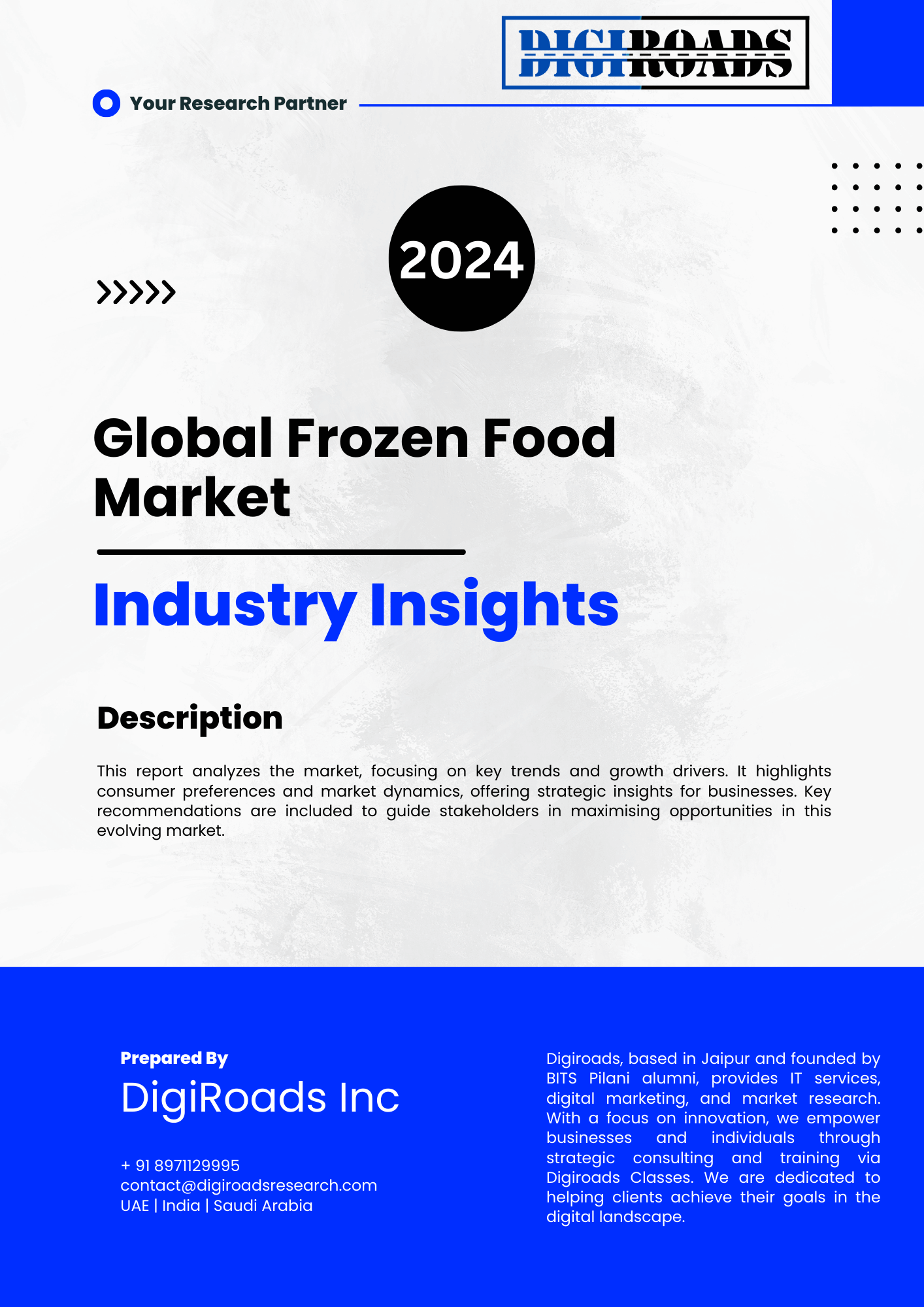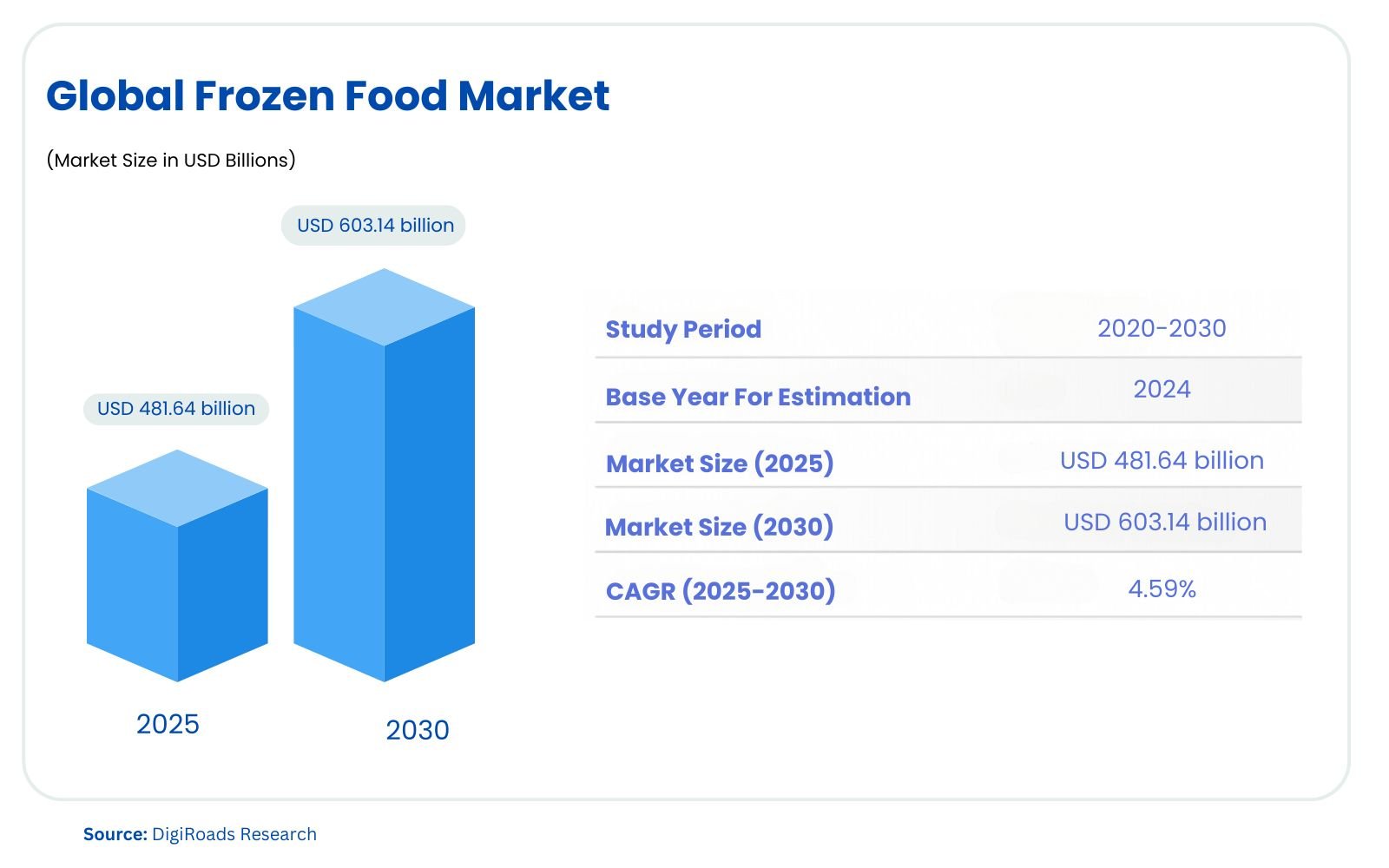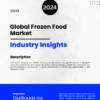Global Frozen Food Market
- Brand: DigiRoads
Global Food and Beverage Market Report on Frozen Food: This 100+ pages report provides comprehensive insights into market trends, key growth factors, and competitive landscape. Available in PDF and Excel formats for thorough analysis and easy data access.
Global Frozen Food Market Report | Market Size, Industry Analysis, Growth Opportunities, & Forecast (2025-2030)
Global Frozen Food Market Overview
The global Frozen Food Market is witnessing remarkable growth, with an estimated market size of USD 481.64 billion in 2025, projected to reach USD 603.14 billion by 2030, expanding at a CAGR of 4.59% during the forecast period 2025-2030. The global frozen food market is poised for significant growth from 2025 to 2030, driven by increasing consumer demand for convenience, variety, and accessibility. The market is expanding rapidly, with key segments such as frozen ready meals, frozen snacks, seafood, and meat products experiencing robust growth. This rise is fueled by factors like busy lifestyles, rising disposable incomes, and technological advancements in packaging, which extend shelf life and improve product quality.
Supermarkets, hypermarkets, and online retail channels are expected to dominate distribution, making frozen foods more accessible to a wider audience. Additionally, the growing demand for plant-based and organic frozen options reflects changing consumer preferences toward healthier, sustainable choices. Regions such as Europe and Asia-Pacific are anticipated to lead the market, with emerging economies further contributing to growth due to higher employment rates and changing dietary habits.
With the introduction of innovative processing technologies like flash freezing and high-pressure processing, the market is expected to thrive in the coming years. This report offers an in-depth analysis of the market’s trends, opportunities, and competitive landscape.
Market Report Coverage:
The “Global Frozen Food Market Report—Future (2025-2030)” by Digiroads Research & Consulting covers an in-depth analysis of the following segments in the market.
| Product Type | Frozen Fruits, Frozen Meat, Frozen Meals, Frozen Desserts, Frozen Snacks |
| Distribution Channel | HoReCa, Retail (Supermarkets, Convenience Stores, Online) |
| Geography | North America, Europe, Asia-Pacific, South America, Middle East & Africa |
Study Assumptions and Definitions
The study of the Global Frozen Food Market is based on several key assumptions to ensure the accuracy and relevance of the data presented. These assumptions include that the market conditions, technological advancements, and economic factors influencing the frozen food industry will remain consistent during the forecast period from 2025 to 2030. The market growth is expected to be driven by the increasing demand for convenience foods, changing consumer lifestyles, and advancements in freezing technologies, such as flash freezing and high-pressure processing.
Definitions used in this report are as follows:
- Frozen Food: Products that are preserved under low temperatures to extend shelf life and retain nutritional content. These include ready-to-eat meals, vegetables, fruits, meats, snacks, and desserts.
- Ready-to-eat: Foods that require no further preparation before consumption.
- Ready-to-cook: Foods that require minimal preparation, such as defrosting or cooking, before being consumed.
- HoReCa: The hospitality industry, including hotels, restaurants, and cafés, as a key distribution channel.
- Retail: Distribution through supermarkets, convenience stores, and online platforms.
Market Scope
The Global Frozen Food Market report covers a comprehensive analysis of the industry from 2025 to 2030, focusing on key segments, trends, and growth drivers. The market is segmented by product categories such as ready-to-eat and ready-to-cook foods, with product types including frozen fruits and vegetables, frozen meats, seafood, ready meals, desserts, and snacks. Additionally, it analyzes distribution channels like HoReCa (Hotels, Restaurants, and Cafés) and retail, including supermarkets, convenience stores, and online platforms.
Geographically, the report provides insights into market dynamics across North America, Europe, Asia-Pacific, South America, and the Middle East & Africa. The report also highlights market forecasts, consumer preferences, technological advancements in freezing and packaging, and the growing demand for convenience foods. With a focus on emerging markets, the report provides valuable projections for the period 2025-2030, making it an essential resource for understanding the evolving global frozen food market landscape.
MARKET OUTLOOK
Executive Summary
The Global Frozen Food Market is expected to experience significant growth from 2025 to 2030, driven by the increasing demand for convenience, ready-to-eat meals, and innovations in freezing technologies. In 2025, the market is anticipated to reach USD 481.64 billion and is projected to grow at a compound annual growth rate (CAGR) of 4.59%.
Key growth drivers include the rising adoption of frozen foods due to their convenience, longer shelf life, and diverse product offerings across multiple categories such as frozen vegetables, meats, ready meals, snacks, and desserts. Additionally, the increasing number of working women, busy lifestyles, and the growing trend of online retail are contributing to market expansion. Technological advancements, such as flash freezing and high-pressure processing, have improved product quality, further fueling demand.
Europe is expected to hold the largest market share in 2025, with North America and Asia-Pacific following closely behind. The Asia-Pacific region, in particular, is forecast to witness the highest CAGR during the forecast period, driven by changing consumer preferences and economic growth in emerging markets like China and India.
The market is segmented by product categories, including ready-to-eat and ready-to-cook foods, and further divided by distribution channels like HoReCa and retail, including supermarkets, convenience stores, and online channels. As consumer preferences shift towards healthier and more natural frozen food options, companies are investing in clean-label products and innovative packaging solutions.
The leading players in the market, including Nestlé, General Mills, Unilever, and Tyson Foods, are continuously innovating and expanding their portfolios to meet changing consumer demands, positioning the market for robust growth through 2030.
COMPETITIVE LANDSCAPE
The Global Frozen Food Market is moderately fragmented, with regional and multinational players competing fiercely for market share.
Key Market Players
- Nestlé SA
- General Mills Inc.
- Unilever PLC
- Tyson Foods Inc.
- The Kraft Heinz Company
- McCain Foods Limited
- Conagra Brands Inc.
- Nomad Foods Ltd
- Hormel Foods Corporation
- Ajinomoto Co. Inc.
Market Share Analysis
The global frozen food market is highly competitive, with key players dominating significant market shares. In 2025, Europe holds the largest share of the market, driven by its strong retail network, consumer preferences for convenient meal options, and robust distribution channels through supermarkets, hypermarkets, and online platforms. North America also contributes significantly to the market, with the United States being the largest market due to a high demand for frozen ready meals and snacks.
Asia-Pacific is projected to witness the highest growth rate over the forecast period from 2025-2030, as emerging economies like China and India experience rising disposable incomes, urbanization, and shifting consumer preferences toward frozen food products. Additionally, the growing popularity of online retailing is enhancing accessibility in this region.
Market leaders like Nestlé, General Mills, and Unilever have strengthened their positions by expanding their product portfolios, launching innovative products, and making strategic acquisitions. Smaller regional players and local brands also contribute to the competitive landscape by focusing on specific consumer needs, such as organic and ethnic frozen foods.
The frozen food market’s competitive dynamics suggest that while the major players continue to lead, emerging regional players and evolving consumer preferences are shaping market
MARKET DYNAMICS
Market Drivers and Key Innovations
The global frozen food market is driven by several key factors. The growing demand for convenience foods is one of the primary drivers. As consumers lead increasingly busy lifestyles, the need for ready-to-eat and easy-to-cook meals has surged. Frozen foods, offering long shelf life and minimal preparation time, cater to this demand. Additionally, the rise in disposable incomes, particularly in emerging markets like Asia-Pacific, has boosted the purchasing power of consumers, further driving the demand for frozen food products.
Technological advancements in packaging and freezing methods also play a significant role in propelling market growth. Innovations such as flash freezing and high-pressure processing help preserve the nutritional value, taste, and texture of frozen foods, making them more appealing to health-conscious consumers. Moreover, smart packaging with temperature monitoring ensures that products remain fresh during transit and storage, enhancing product quality and consumer trust.
The increasing preference for online shopping has further fueled market growth. The proliferation of e-commerce platforms provides consumers with easy access to a wide range of frozen food products, expanding the market reach and convenience.
Key innovations within the market include the development of plant-based frozen meals, ethnic frozen food options, and frozen snacks, catering to evolving consumer tastes. Major players are also investing in sustainable packaging solutions and environmentally friendly freezing techniques, aligning with the growing demand for eco-conscious products.
These drivers and innovations highlight the dynamic nature of the frozen food market, with both consumer needs and technological progress shaping its future trajectory.
Market Challenges
- Health Concerns: Increased consumer awareness about the health risks of consuming processed foods, including high sodium and preservatives, may limit the demand for certain frozen food products.
- Price Sensitivity: The higher cost of frozen foods compared to fresh alternatives, especially in emerging economies, could hinder market growth in price-sensitive regions.
- Storage and Supply Chain Issues: The need for constant cold storage throughout the supply chain increases operational costs and may lead to distribution challenges, particularly in regions with limited refrigeration infrastructure.
- Environmental Impact: Concerns about the environmental footprint of frozen food production and packaging, including energy consumption and plastic waste, are pushing companies to adopt more sustainable practices, which can increase costs.
- Competition from Fresh and Local Foods: As consumers increasingly prioritize fresh and locally sourced foods, frozen foods may face stiff competition, particularly in regions with strong agricultural sectors.
- Changing Consumer Preferences: Shifts toward plant-based, organic, and fresh food options pose challenges for frozen food companies that need to adapt to new dietary trends while maintaining product appeal.
- Supply Chain Disruptions: Global events such as pandemics or geopolitical tensions can disrupt supply chains, affecting the availability of raw materials and the distribution of frozen food products.
Market Opportunities
- Growing Demand for Convenience Foods: Increasing urbanization, hectic lifestyles, and the need for quick meal solutions provide significant opportunities for frozen ready-to-eat and ready-to-cook food products.
- Expansion in Emerging Markets: Rising disposable incomes, urbanization, and changing consumer lifestyles in emerging economies, especially in Asia-Pacific, present opportunities for frozen food manufacturers to expand their market presence.
- E-commerce Growth: The rise of online grocery shopping creates new distribution channels for frozen food products, allowing manufacturers to reach a broader consumer base, especially in regions with limited physical retail access.
- Product Innovation and Variety: Introducing new, healthy, and innovative products such as plant-based frozen meals, organic frozen foods, and low-calorie options can help companies capture the attention of health-conscious consumers.
- Technological Advancements: Investing in technologies like flash freezing, high-pressure processing, and smart packaging can enhance product quality, extend shelf life, and improve food safety, offering competitive advantages in the market.
- Sustainability Trends: With growing consumer demand for eco-friendly packaging and sustainable sourcing, frozen food brands that adopt green practices, such as recyclable packaging and energy-efficient production methods, can tap into a socially responsible market.
- Increase in Global Tourism and HoReCa Demand: Growth in the travel and hospitality sector, along with higher consumption in hotels, restaurants, and catering services (HoReCa), opens up additional avenues for frozen food sales.
RECENT STRATEGIES & DEVELOPMENTS IN THE MARKET
Expansion into Emerging Markets:
- Companies are expanding their presence in high-growth markets like Asia-Pacific and Latin America. For example, Nestlé has made significant inroads in the Chinese market with its frozen food offerings, responding to increasing consumer demand for convenient meal options.
Focus on Product Innovation:
- Major players are focusing on introducing new product varieties to meet changing consumer preferences, such as plant-based frozen foods. For instance, Unilever has launched a range of plant-based frozen meals under its “The Vegetarian Butcher” brand to tap into the growing demand for vegan and vegetarian options.
Adoption of Smart Packaging and Technology:
- Companies are leveraging advanced packaging technologies, such as smart packaging that includes temperature monitoring, to ensure product quality and safety. McCain Foods has adopted high-tech packaging solutions to extend the shelf life and improve consumer experience.
Investment in Sustainability:
- Many brands are focusing on sustainability as part of their long-term strategies. For instance, General Mills has committed to using 100% recyclable or compostable packaging for its frozen food products by 2025, aiming to reduce environmental impact.
E-commerce and Online Distribution Channels:
- With the growing popularity of online grocery shopping, companies like Tyson Foods and Nestlé are enhancing their e-commerce capabilities. Tyson Foods has partnered with major online retailers to offer frozen food products through various digital platforms, increasing consumer reach.
Collaborations and Acquisitions:
- Major companies are acquiring smaller firms to expand their portfolio. For example, in 2020, Nomad Foods acquired the frozen food brand, Findus, to broaden its product offerings and strengthen its market position in Europe.
Health and Wellness Trends:
- Frozen food companies are introducing healthier options to align with consumer demand for nutritious products. Kraft Heinz, for example, has expanded its frozen food line with low-calorie, high-protein meals targeting health-conscious consumers.
KEY BENEFITS FOR STAKEHOLDERS
Increased Market Reach:
- Stakeholders, including manufacturers and distributors, can benefit from expanding their presence in emerging and high-growth markets like Asia-Pacific and Latin America, where demand for frozen food products is increasing due to changing lifestyles and growing urbanization.
Consumer Demand for Convenience:
- As consumers increasingly prefer convenient, ready-to-eat or ready-to-cook food options, stakeholders can tap into this growing demand by offering a wide variety of frozen food products, such as frozen meals, snacks, and vegetables, catering to diverse preferences and needs.
Opportunities for Innovation:
- Frozen food producers can capitalize on the growing trend for healthier, plant-based, and organic frozen foods. Innovations such as plant-based frozen meals and low-calorie products offer a competitive edge and appeal to health-conscious consumers, creating new revenue streams.
E-commerce Growth:
- The rapid growth of online shopping provides an opportunity for stakeholders to tap into the expanding online retail market for frozen food. E-commerce platforms allow manufacturers to directly reach consumers, expanding their customer base and enhancing brand visibility.
Sustainability Initiatives:
- By adopting eco-friendly packaging and production practices, stakeholders can improve their sustainability profiles. Consumers are increasingly prioritizing sustainable brands, and this can lead to improved brand loyalty, higher sales, and alignment with global environmental standards.
Strategic Partnerships and Acquisitions:
- Mergers, acquisitions, and partnerships in the frozen food industry provide stakeholders with opportunities to diversify product offerings, enhance market share, and leverage synergies that drive growth and operational efficiencies.
Profit Growth Through Global Expansion:
- As global disposable incomes rise, particularly in emerging economies, stakeholders can benefit from expanding operations to meet the growing demand for premium frozen food products in these regions, leading to substantial revenue growth.
At DigiRoads Research, we emphasize reliability by employing robust market estimation and data validation methodologies. Our insights are further enhanced by our proprietary data forecasting model, which projects market growth trends up to 2030. This forward-thinking approach ensures our analysis not only captures the current market landscape but also anticipates future developments, equipping stakeholders with actionable foresight.
We go a step further by offering an exhaustive set of regional and country-level data points, supplemented by over 60 detailed charts at no additional cost. This commitment to transparency and accessibility allows stakeholders to gain a deep understanding of the industry’s structural and operational dynamics. By providing exclusive and hard-to-access data, DigiRoads Research empowers businesses to make informed strategic decisions with confidence.
In essence, our methodology and data delivery foster a collaborative and data-driven decision-making environment, enabling businesses to navigate industry challenges and capitalize on opportunities effectively.
Contact Us For More Inquiry.
Table of Contents
-
INTRODUCTION
- Market Overview
- Years Considered for Study
- Market Segmentation
- Study Assumptions and Definitions
- Market Scope
-
RESEARCH METHODOLOGY
-
MARKET OUTLOOK
- Executive Summary
- Market Snapshot
- Market Segments
- Product Type:
- Frozen Fruits, Frozen Meat, Frozen Meals, Frozen Desserts, Frozen Snacks
- Distribution Channel:
- HoReCa, Retail (Supermarkets, Convenience Stores, Online)
- Geography:
- North America, Europe, Asia-Pacific, South America, Middle East & Africa
- Product Type:
-
COMPETITIVE LANDSCAPE
- Recent Strategies (Key Strategic Moves)
- Market Share Analysis
- Company Profiles
- Nestlé SA
- General Mills Inc.
- Unilever PLC
- Tyson Foods Inc.
- The Kraft Heinz Company
- McCain Foods Limited
- Conagra Brands Inc.
- Nomad Foods Ltd
- Hormel Foods Corporation
- Ajinomoto Co. Inc.
-
MARKET DYNAMICS
- Market Drivers
- Market Challenges
- Market Opportunities
- Porter’s Five Forces’ Analysis
- Bargaining Power of Suppliers
- Bargaining Power of Buyers
- Threat of New Entrant
- Threat of Substitutes
- Competitive Rivalry
-
GLOSSARY OF PROMINENT SECONDARY SOURCES
-
DISCLAIMER
-
ABOUT US



